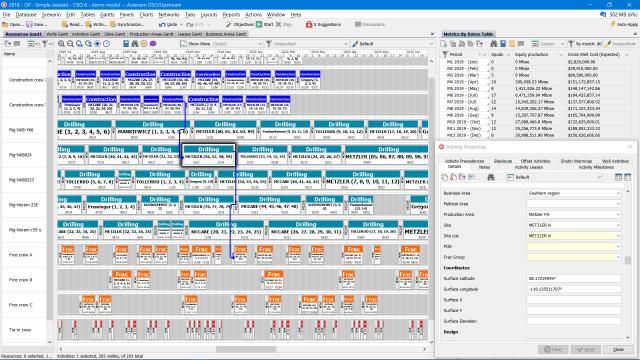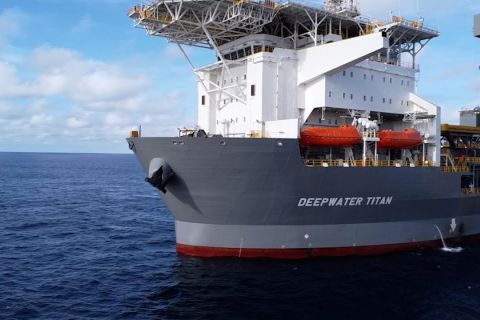
This resource schedule shows equity production and well costs for 2019 as well as drilling activity data. (Source: Actenum)
Well delivery scheduling is a lot like chess. It involves coordinating many moving parts in an operational environment that is constantly changing to reach a goal that is often altered in response to business needs. Accurate scheduling improves organizational responsiveness to operational changes and yields significant economic benefits. But the consequences of a poor schedule can be severe: deferred production, cycle time delays and increased costs.
Spreadsheets and project management software tools are still widely used by operators to accomplish this complex task. These tools are ill-suited for modeling the complicated integrated activity sequences and related data necessary for efficient and timely well delivery.
Current tools lack intelligence
Spreadsheets allow rapid import and display of data in a tabular form and may be used to create simple Gantt charts. But they provide no real support for making effective decisions about how to schedule. Well delivery schedules based on a master spreadsheet usually incorporate several sub sheets, and often these are not in sync, resulting in poor communication and a lack of coordination in the field, leading to delays and cost overruns.
An operator in the Permian Basin was managing drilling and completion schedules using separate spreadsheets, which were also separate from construction schedules. Identifying all resource and timing requirements was difficult, leading to schedule conflicts, poor productivity and overscheduled resources. These scheduling shortcomings weren’t just leading to frustration; they were causing serious red ink in the financial department. Planners determined that when changes were required as a result of a schedule conflict, an average of two extra rig moves were needed, along with the redeployment of other equipment. At an approximate cost of $60,000 per move and an average of four major conflicts each year, $480,000 in overruns were dramatically adding to annual expenses.
Project management tools provide interfaces to a calendar, catalogs of activities defining work to be done and resources required to complete those various activities. Out of the box, they understand nothing about well delivery scheduling. Optimizing a schedule to meet business objectives—taking into consideration lease, production and location information, multiwell pads, the risk of offset well violations and use of frac water—is either impossible or extremely time-consuming. The scheduler must make all the decisions about how to arrange the sequences of activities manually. There is no automation available to help place tasks on a time line and no intelligence to help sort out complex situations or make decisions.
Rules-based operations model
Just as when IBM taught Deep Blue to play chess, to automate well delivery scheduling the rules of the game must be defined in the software. How does each type of activity, piece of equipment or milestone in the oil well scheduling game work? What “moves” can each resource make? What are the constraints regarding sequencing and dependencies?
Rules like “Truck B can only carry equipment under 300 tons” or “Property A must be drilled by November 7, 2020, according to the lease and needs to use water from frac pond D22” describe constraints that must be considered. All these things can be defined to produce an effective and efficient schedule. But once basic rules are defined, and scheduling logic is established, then many different rules must be applied to each specific activity, including timing (earliest starts, priorities and deadlines), contract and lease obligations, spacing and SIMOPS constraints, blackouts and facilities. With tens or hundreds of wells to be drilled each year, a manual approach is not feasible: central processing unit power is required to work out each schedule.
Rapid sequence assessment and optimization
Following the chess analogy, Deep Blue’s advantage was speed. Given a set of rules that govern an upstream operation, modern scheduling software is able to rapidly run through the millions of alternatives available to create an optimal activity sequence that reaches goals like production targets, cost ceilings or both. But this is not just about brute force pattern assessment. As operations increase in size and scope, just adding computing power is not enough to improve time to solution. An optimization engine also is required to make the scheduling tool “intelligent.” Powerful optimization algorithms greatly increase the speed at which all rules and constraints are assessed and appropriate alternatives are found. A typical schedule involving 60 pads, 200 wells and eight rigs, which might take a week to build manually with spreadsheets, will be assembled in a few minutes and continue optimizing over a very short time.
Adapt to change, introduce new goals
In upstream well delivery, there are usually multiple, changing goals. One day drilling is at full steam. The next month production needs to be cut back due to price fluctuations, or new acreage is acquired and must be factored into the schedule. Scheduling software should be able to take such inevitable changes, incorporate them into sequence optimization and quickly produce a revised schedule. Not in days, but in minutes.
When Rig A needs to stay at Well 312 for a few extra days because of stuck pipe or a breakdown, how does that impact the schedule? By altering the deadline associated with Rig A’s activity, the schedule should quickly reoptimize, taking this change in stride. Moreover, it should enable the user to answer all those tricky questions about what happens to other rigs and well deadlines, plus cost changes, in minutes instead of hours or days.
Rapid optimization gives you the flexibility to alter any part of a schedule—the goals, the rules and the scheduling logic—and obtains updated information in near to real time, leading to more efficient and effective operations despite disruptions and changes.
Schedule optimization software signals the beginning of far more effective and efficient well delivery than before. It provides a single source of truth for all activities (i.e., no extra spreadsheets or files floating around with details about the schedule). The current method of publishing PDF documents from a spreadsheet or sharing them through email or Microsoft SharePoint is time intensive and clunky. No one sees the same information at the same time, and it is impossible to understand the implications of individual changes on costs or production. A single platform that team members can access anywhere promotes collaboration and 24/7 planning from anywhere on the globe.
Scheduling software should maximize the efficient use of costly resources, warn of operational risks like well interference or continuous drilling provisions and ensure efficient well delivery. In the end, it elevates the task to a strategic advantage.
Recommended Reading
E&P Highlights: Feb. 26, 2024
2024-02-26 - Here’s a roundup of the latest E&P headlines, including interest in some projects changing hands and new contract awards.
Shell Taps TechnipFMC for 20K System for Sparta
2024-02-19 - The deepwater greenfield project in the Gulf of Mexico targets reserves in the high-pressure Paleogene reservoir.
E&P Highlights: March 4, 2024
2024-03-04 - Here’s a roundup of the latest E&P headlines, including a reserves update and new contract awards.
After 4Q Struggles, Transocean’s Upcycle Prediction Looks to Pay Off
2024-02-21 - As Transocean executives predicted during third-quarter earnings, the company is in the middle of an upcycle, with day rates and revenues reaching new heights.
Rystad: More Deepwater Wells to be Drilled in 2024
2024-02-29 - Upstream majors dive into deeper and frontier waters while exploration budgets for 2024 remain flat.




